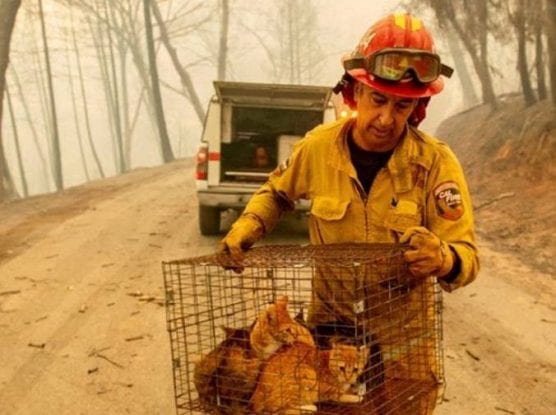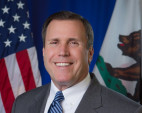By Nick Cahill
SACRAMENTO – As the state’s largest utility pursues bankruptcy and with another wildfire season looming, California is teaming with two influential firms to protect residents and its energy grid against climate change.
In a report released Friday, advisers are pushing the Legislature and Gov. Gavin Newsom to swiftly increase wildfire prevention efforts, commit to clean energy and expand oversight of the state’s embattled utilities.
“If anyone is wondering if climate change is real, come to California,” Newsom said at a press conference Friday. “Since 2000, 15 of the top 20 most catastrophic and destructive wildfires have occurred.”
Newsom briefed the media from the state’s emergency services headquarters on a report titled “Wildfires and Climate Change: California’s Energy Future,” prepared by the firms O’Melveny and Myers and Guggenheim Securities. He called it an “outline and an educational exercise” meant to guide the state’s next moves on climate change, energy and wildfires.
The report says climate change has fueled a new “wildfire reality” for the Golden State and the 11 million residents living in fire zones. Meanwhile, regulators must clamp down on utilities that have been blamed for sparking many of the most destructive fires in the state’s recent history, according to the report.
Less than two months after the Camp Fire ripped through Butte County, Pacific Gas & Electric filed for bankruptcy in San Francisco. The utility – the nation’s largest – has warned investors it could be facing $30 billion or more in wildfire liability and has since overhauled its executive board.

California Governor-elect Gavin Newsom on election night, Nov. 5, 2018.
Through a process called inverse condemnation, California allows private utilities like PG&E to install equipment on private property. But the law also says if their equipment contributes to a wildfire, they are held responsible for the damages – even if they aren’t found to be at fault.
The report says the law increases bankruptcy risks for utilities and that it may need to be amended to a more fault-based standard. In doing so, the risk of property losses would move from utilities to insurance companies “in cases where the utility was not a bad actor.”
“Bottom line – utilities in or on the verge of bankruptcy are not good for Californians, for economic growth or for the state’s future,” the report states.
Newsom, a Democrat, wouldn’t say whether the state should scrap inverse condemnation. But he noted it will likely be the courts that change the longstanding law, not the Legislature.
Other ideas to spread the cost of wildfire liability include creating a fund that utilities can access to pay wildfire claims while investigators are still determining the cause of a fire, and a separate “catastrophic wildfire” fund that would spare ratepayers from rate hikes often passed on by utilities after disasters.
Newsom challenged lawmakers to study the report and send him solutions within 90 days. He also promised any fixes he approves won’t go easy on PG&E.
“I expect the investors that are involved in PG&E to participate in the solutions and I expect that PG&E is going to get serious and no longer misdirect, manipulate and mislead the people of this state,” Newsom said.
State Sen. Bill Dodd, a Democrat whose district was ravaged by the Wine Country fires in 2017, says Newsom has been “laser-focused” on making California more fire resilient.
“The bottom line is that given the threat of climate change and catastrophic wildfires, we need to take bold steps to protect the public and ensure affordable, reliable energy delivery,” Dodd said in a statement. “I have been working closely with his office and look forward to partnering to refine and pass a package of reforms to protect the state in this new normal.”
Along with ramping up forest thinning and spreading the cost of wildfires, the report recommends changes at the California Public Utilities Commission. The advisers, or what Newsom has called his “strike force,” want the commission to be “more nimble” and get more involved in rate-setting and utility audits.
Citing an “unstable energy market,” the strike force also called for California to continue moving away from fossil fuels and force utilities to further embrace clean energy.
“A modern transmission and distribution system will create high-quality jobs and long-term economic stability, in addition to making us more resilient to the impacts of climate change and protecting the millions of residents living in fire-prone areas,” the report states.
Newsom says California will no longer be “passive” with its emergency preparedness in the era of climate change.
“We’re in a very precarious state, literally and figuratively, and it requires us to adapt and requires us to be nimble,” Newsom said.
Like this:
Like Loading...
Related





 Tweet This
Tweet This Facebook
Facebook Digg This
Digg This Bookmark
Bookmark Stumble
Stumble RSS
RSS



























REAL NAMES ONLY: All posters must use their real individual or business name. This applies equally to Twitter account holders who use a nickname.
1 Comment
Yeah, yeah, yeah. When profit is risked, corporations will find a way to either blame somebody else, convince “lawmakers” it wasn’t their fault, or hire enough attorneys for bankruptcy to ensure that nobody in charge of those “utilities” has to worry about losing a nickel.
And now that the past requirements for utilities to take on the primary burden of costs from fires started/caused/enhanced by a utility’s negligence have been limited, they no longer have to worry about anything. The costs of future fires started by a “private” electric utility’s lack of care and maintenance will be “shared” with the public. Yup. It will cost US if they are negligent (aka not doing routine maintenance, tree-trimming, upgrading of poles and conductors, etc).
They all could have gone to insulated conductors (wires) many years ago, but the cost of those electric cables would have increased. That would have cut back on profits. They could have increased the spacing between those same conductors so that winds could NOT have slapped them together causing sparks and burning metal falling on tinder-dry grasses, and foliage.
But that would have required major expenses in labor and materials to upgrade hundreds, even thousands of miles of cables. Global warming and tinder-dry forests (not just trees mind you but chapparal – aka everything around here from 500 feet elevations to about 4500′ – as well) are not new conditions. All major utilities have planning programs and are intimately knowledgeable about how weather conditions affect their services – and profits.
But instead of being proactive and planning as well as investing time and money to deal with it, they just kept pumping profits to shareholders – and to themselves.
There really should be tremendous outrage about this.
But, mostly the sheep don’t look up. And the shepherds are too busy counting the fund-raising they get from the folks that they are hired by or voted-in by us, to actually do their jobs.
AKA, protecting us.